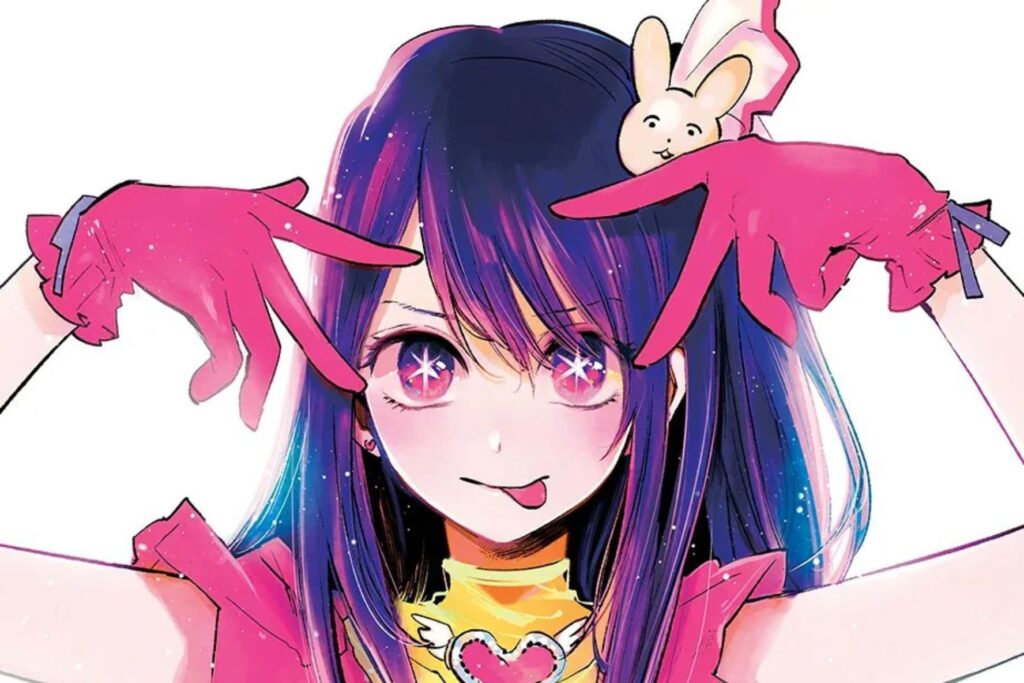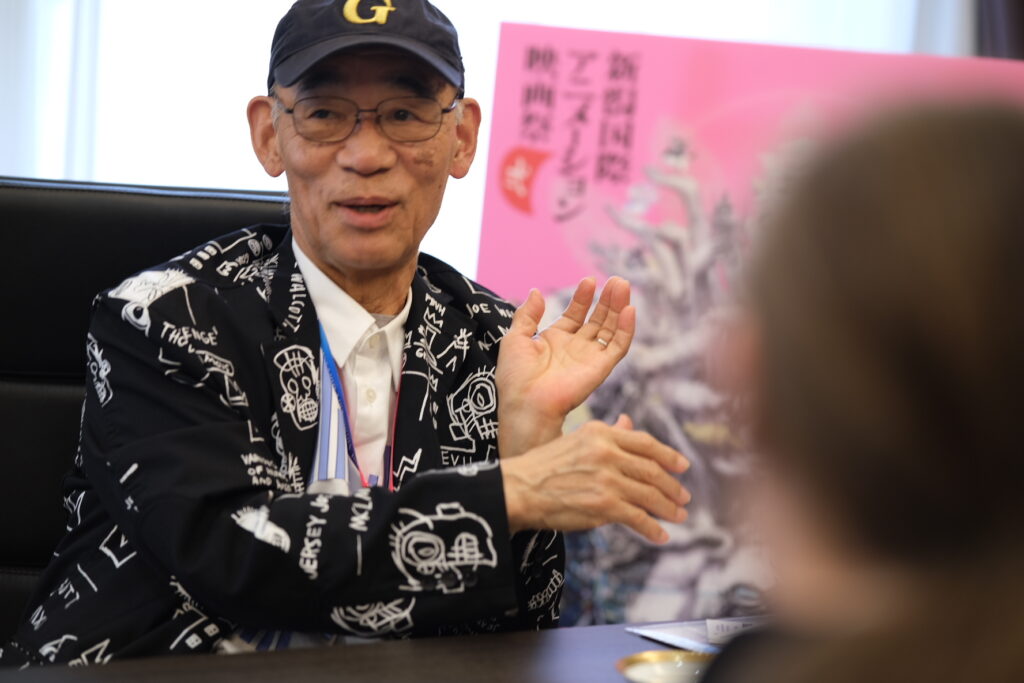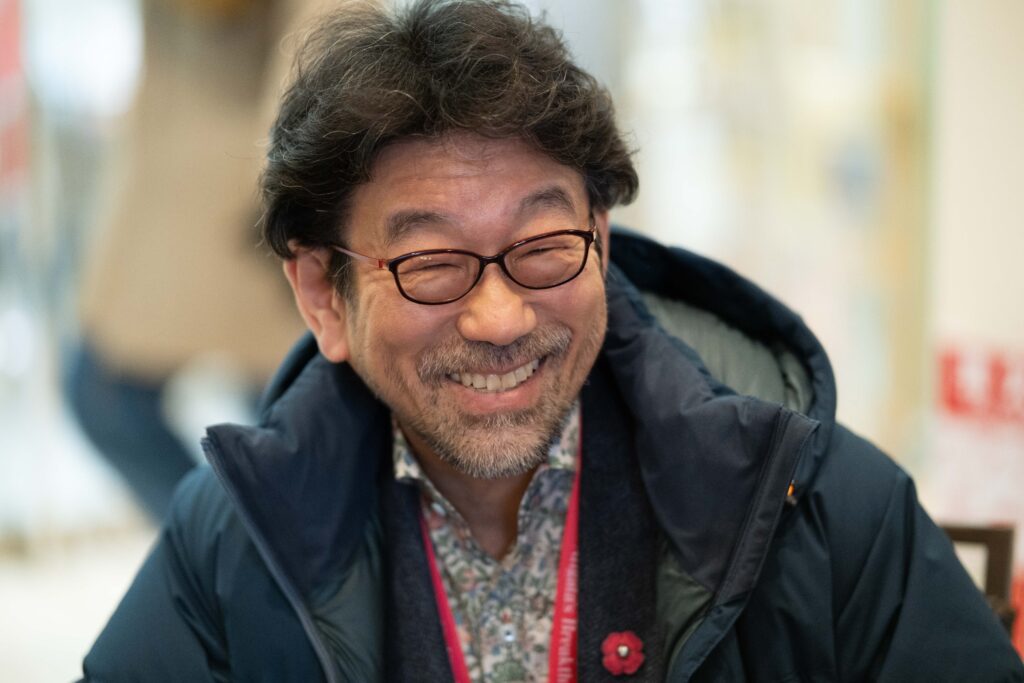Studio Gorilla is a small studio with a long history. As is often the case in the anime industry, its creators are fueled by simple things: love and passion. With these, they have participated in a variety of projects aimed at children, which have always been their main audience.
As part of the studio’s activities, one of the studio’s founding members, Ms. Noko Yukawa, wrote a picture book called The Top Loft. Today, this project is moving to the next stage: with the help of JETRO, they hope to turn into a “moving picture book”, which should be the first step towards an animation work.
For starters, can you introduce yourselves and Studio Gorilla? When was it founded, and who are some of its key members?
Noko Yukawa: I am Noko Yukawa, CEO of Gorilla animation and the original author of the title.
Ms. Haba: I am Ms. Haba, the producer of this project.
Noko Yukawa: We started our studio over 20 years ago. At the time there were a lot of anime studios along the Seibu Ikebukuro line in Tokyo. But when I had my child, I found it very difficult to continue commuting to these studios. There were other animators facing a similar situation in my neighborhood, so with five others, we gathered to start our own animation studio.
What studio were you a member of before creating Gorilla?
Noko Yukawa: It was a small studio called Studio Mates, and I also regularly worked at other very small studios.
All the creators at Studio Gorilla are women, is that right?
Noko Yukawa: At the start, yes. We were all young mothers.
Was it particularly difficult for women to work in animation at the time?
Noko Yukawa: It was… Day and night were completely reversed. We would often need to work until midnight, but we also had to go pick up our kids at 5p.m. so it was quite a difficult situation.
And can you tell us why you chose the name Gorilla?
Noko Yukawa: Since we were five, that’s where the Go [five in Japanese] comes from. One of the founding members is from Hokkaido and she loves lilac flowers. So we combined “Go” and “Lilac” together, which in Japanese is written like Gorilla. It also makes us feel very strong!
You specialize in animation targeted at children. What motivated that choice?
Noko Yukawa: Because we are all mothers and raising our kids, we care a lot about children, so that’s what we were interested in.
Among the studio’s works, you contributed a lot on Hometown Rebuilding: Folktales from Japan. Can you tell us about your involvement in it?
Noko Yukawa: Regarding this series, there are a lot of old folktales in Japan. There was a TV series about them before, and this is a different take on it. Our folklore is the pride, the core of Japanese people, we always go back to it. It’s one of our treasures. However, we live in a very different world today, with electricity for example, so today’s children may find it difficult to understand these stories.
For people in my generation, we can still understand how things were in the old days. But when it comes to kids these days, they can’t even imagine a window without glass. They have no idea what a traditional Japanese window is like. I want to convey the good things from old times. If we don’t do this now, we will lose these traditions. That’s what motivates my passion for it.
The reason why we Japan has kept so many folktales is also because of the appeal of its characters, and I’d also like to keep them alive.
Are there any specific tales that you particularly like and wanted to adapt into animation?
Noko Yukawa: I don’t have any specific one I wanted to adapt into animation. But a lot of stories have already been lost to time, so I wanted to be able to preserve as many of them as possible.
Among the various animated adaptations of Japanese folktales the most famous one is probably Group TAC’s Manga Nippon Mukashibanashi. Do you have any specific relationship to it maybe?
Noko Yukawa: Rather than the work itself, I have been greatly influenced by the artists who worked on it, such as Tsutomu Shibayama or Osamu Kobayashi. They had a huge impact on me.
Among the interviews we have been doing around this initiative, we have also interviewed Studio Ekura Animal. Mr. Honda, who worked on Manga Nippon Mukashibanashi, works there.
Noko Yukawa: Ah yes, I have been acquainted with Mr. Honda for a long time! [laughs]
Let’s talk about the project you are producing this time. Can you first introduce its origins?
Noko Yukawa: We had been working on Hometown Rebuilding: Folktales from Japan for many years. We were very implicated in it. But because it was a TV series, it eventually ended. We thought about what to do next, and since we were all animators, we’re good at creating things. We thought we should try to make our own original projects. That’s how it started.
At the time we were discussing what to do next I had created a picture book and I suggested: “What do you think about doing something with this?” Everyone resonated with this idea, so we decided to start this project. We’re a small company, so we immediately got to work.
[Ms. Yukawa shows the picture book as well as dolls she created]
Noko Yukawa: At first, I did this picture book, but then, one of the members was inspired by the tower from the book and decided to reproduce the tower and built a replica in their garden. Then, we also organized a small exhibition in a café, and one of the visitors made dolls of the characters to make a play with… The person who built the replica of the tower also recreated all the objects inside!
So I see you have a lot of other activities besides animation!
Noko Yukawa: We mostly do animation and illustration, and also create characters. What I just mentioned was a sort of extra-curricular activity [laughs].
Is this Gorilla’s first original project?
Noko Yukawa: Yes.
Were there any difficulties with doing something original?
Noko Yukawa: When we decided we’d do it, we participated to an event called Design Festa. The visitors really liked what we did, especially the tower. But this generated almost no revenue… We’re creators, so we’re good at doing this, but not at selling things or making revenue… That’s what we learnt.
We also learnt about the Tokyo Pitch Grand Prix at the MIFA in Annecy and we participated in it.
Ms. Haba: I arrived on the project just after that, but I also went to MIP Junior 2022. The most difficult thing was that, when discussing the project, I put all my passion and it seems like I managed to show what’s good about our project… but after the events, when I contact the potential partners, it never goes further. The creation itself might be good, but there’s something missing when we try to sell it, and we’re not sure what that is. Funding and marketing are very difficult.
I’ve had similar experiences as a journalist (laughs). When we meet people the first time they seem really interested, but later, when we ask about interviews or things like that, they never answer…
Ms. Haba: When I meet people, they’re always very passionate, but I’m Japanese, so I can’t help believing they’re overreacting and I’m never sure if they’re sincere… That’s something I have to learn more about [laughs]. Japan is an island country, so we’re not used to communicating a lot, especially with people from the rest of the world.
Coming back to this Kickstarter, if we are able to create a “moving picture book” with this campaign, our next plan is to make it into animation. We believe the data from this campaign will be useful for its sales.
Did you publish the original books through a Kickstarter campaign as well?
Ms. Haba: The first production was completely self-published. With this campaign, I wanted to make it into a digital “moving picture book” to make it more widely known to more people.
Could you tell us more about the “moving picture book” concept?
Ms. Haba: There will be voice-over for the narration and dialogues, as if the story were read to children, and the pictures will move a bit to match it. But it’s not animation, which moves on its own and the viewer is passive. But for picture books, children read it and look at it at their own pace. It’s proactive, and each child can follow their own interests. We don’t want to take that away, so for example, in a scene with many characters, it will stay still so that children can focus on what they want. But when one character speaks, then it will focus on them… We’re trying to combine the advantages of animation and picture books.
The style from the images you shared is a bit different from the picture book you just showed us. How did you switch from one format to the other?
Noko Yukawa: The visuals were difficult to adapt, but we discussed it within the studio and explored various possibilities in order to keep as much from the original picture book.
Ms. Yukawa, did you make the designs again for the new version?
Noko Yukawa: Yes.
Who are some of the other members of the team?
Noko Yukawa: There’s four people besides myself, who are all core members of Gorilla. The director and storyboarder is one of the founders of the studio, and then there are two younger members. They’re good at using digital tools, so they’re taking charge of the characters and animation as well as the photography and compositing.
Ms. Haba: In the end, the responsibilities aren’t clearly divided. Of course, everyone is better at something or other, but we all collaborate. So Ms. Yukawa’s designs served as a base, but everybody worked on them afterwards.
I believe this kind of collaborative work is really what makes small studios like yours special.
Ms. Haba: Thank you! We’d like to be “special” as well [laughs].
But I imagine that it’s still difficult to be a small studio in the big Japanese industry?
Noko Yukawa: That’s right. Up until now, we did subcontracting, but now we’re developing things of our own, and we can’t do everything by ourselves. Moreover, for our business to remain sustainable, we must focus on doing what we can do, so it’s difficult to find a good balance between everything.
Going back to the picture book, is it the first time that Ms. Yukawa writes one?
Noko Yukawa: There are actually a few others, but this is the one that worked the best!
What is it that you like about making picture books?
Noko Yukawa: It’s doing things how I like them. In this line of work, it’s difficult to do original things, but I can express my originality with picture books.
Moreover, there are many messages that I want to share. When you raise children, you discover many things: nowadays, a lot of things are forced on children, they’re forced to accompany their parents here and there, even though they might just want to play… So I want to say that we should respect the freedom of children, and that making friendships is very important. I want to support that freedom.
When I was small, I played all day, and when I came back home, the sunset was always so beautiful. When I saw that, I always asked myself “what’s beyond this?” This book is my answer to that question [laughs].
That’s a beautiful story, thanks for sharing it! Would you have another final message for the supporters of the campaign?
Noko Yukawa: The three characters in The Top Loft are full of energy, and I want them to go out into the wide world. They’re still very small, but they’re about to start on their own journeys. We want to support them on that – it’s like our duty.
Actually, we made previews with children multiple times, and they always loved it and were very curious about it. They made all kinds of drawings, and even though they’re not things that are in the story, they could exercise their imagination and show their interest through this. We’re trying to put all the things children might like in this story.
Oshi no Ko & (Mis)Communication – Short Interview with Aka Akasaka and Mengo Yokoyari
The Oshi no Ko manga, which recently ended its publication, was created through the association of two successful authors, Aka Akasaka, mangaka of the hit love comedy Kaguya-sama: Love Is War, and Mengo Yokoyari, creator of Scum's Wish. During their visit at the...
Ideon is the Ego’s death – Yoshiyuki Tomino Interview [Niigata International Animation Film Festival 2024]
Yoshiyuki Tomino is, without any doubt, one of the most famous and important directors in anime history. Not just one of the creators of Gundam, he is an incredibly prolific creator whose work impacted both robot anime and science-fiction in general. It was during...
“Film festivals are about meetings and discoveries” – Interview with Tarô Maki, Niigata International Animation Film Festival General Producer
As the representative director of planning company Genco, Tarô Maki has been a major figure in the Japanese animation industry for decades. This is due in no part to his role as a producer on some of anime’s greatest successes, notably in the theaters, with films...





Recent Comments